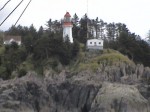– Jeannie (Hartt) Nielsen (daughter of Ed Hartt, Senior Keeper on Langara 1957 – 1963)

I had gone by myself to the cabin for a weekend, and in the evening of the second day I was sitting in front of an open campfire watching the sun set. As the sun sank in the sky, a fast moving band of black cloud moved in.
By midnight that night, the wind was screaming, and the sound of the ocean was ferocious. I could see nothing in the black night, and shone my flashlight toward the bay. All I could see was spray and white water. I watched anxiously for any sign of water coming in under the cabin walls, as the cabin was not far from high tide mark. And from the sound of the ocean, it was wild out there. I was scared. I laid awake all night listening to the sounds of crashing branches, and just hoped that one of the giant trees around the cabin wouldn’t come down. It would have been foolhardy to try to go home in the dark, so all I could do was wait it out.
In the morning my dad appeared at the door to see if I was okay. He said the storm was actually a hurricane, and hit winds at over 105 mph. A barge was driven aground on the Queen Charlottes . I learned later that the storm actually had a name, Hurricane Freda1 (October 12 – 13 1962). As far as I know it is the only west coast storm that rated it’s own name! It was a night I will never forget.
********************************
FOOTNOTE:
| Category 3 typhoon (SSHS) | |||
|---|---|---|---|
|
|||
| Duration | October 3 – October 10 | ||
| Intensity | 185 km/h (115 mph) (1-min), 948 mbar (hPa) | ||
As an extratropical storm, Freda caused an estimated $10 million (1962 USD ($74.8 million (2011 USD)) in damage, with 46 deaths occurring. – Wikipedia
